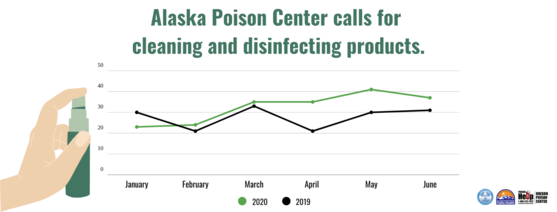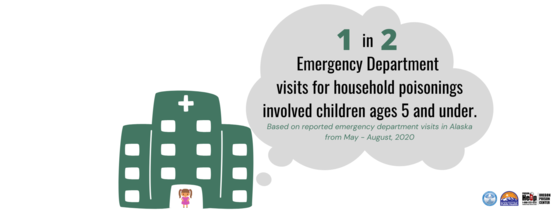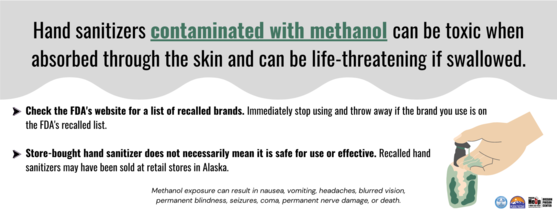Alaska Poison Center receives poison exposure calls during the pandemic
September 28, 2020 update - Alaska families are spending more time cleaning and disinfecting their homes and hands to protect loved ones from COVID-19. The Alaska Poison Center provides 24-hour professional advice and management information regarding exposures to poisons, chemicals, drugs, bites, and medications to residents of Alaska. Since January 2020, the Alaska Poison Center has received over 200 calls associated with possible poisonings from disinfectants and cleaners.
Bleach, hand sanitizer, and other cleaners and disinfectants work to kill viruses and bacteria. As COVID-19 spread worldwide in early 2020, the Centers for Disease Control and Prevention (CDC) heightened recommendations for proper cleaning and disinfecting of high-touch areas using household disinfectants and cleaning products. Cleaning and disinfecting continue to be important COVID prevention strategies; however, Alaskans should be aware that some products have been recalled. Other products can be poisonous when handled improperly or when adults and children accidentally swallow or touch them.
 During the first six months of 2020, the Alaska Poison Center received 196 calls related to household cleaning and disinfecting products.
- Nearly 1 out of 3 calls this year involved exposure to bleach.
- Almost 1 out of 2 calls that were related to cleaning and disinfecting products involved children ages 5 or younger (42%).
- Most calls related to cleaning supply exposures among young children involved bleach (23%) and hand sanitizer (22%).
 These numbers are merely a snapshot of poison exposures happening throughout Alaska. Calls to the Alaska Poison Center likely underestimate the total number of poison exposures and the seriousness of those poisonings because the information is limited only to cases when the center received a phone call.
Can hand sanitizer be harmful?
While washing your hands with soap for at least 20 seconds is the preferred and recommended way of cleaning, using hand sanitizer containing at least 60% alcohol can be an effective way to clean your hands when soap and water are not available. Federal regulators, however, are warning people to avoid nearly 150 different hand sanitizer brands because they are contaminated with methanol, a dangerous chemical that can be toxic when absorbed through the skin and can be life-threatening if swallowed.
 Federal regulators, however, are warning people to avoid nearly 150 different hand sanitizer brands because they are contaminated with methanol, a dangerous chemical that can be toxic when absorbed through the skin and can be life-threatening if swallowed. Some contaminated hand sanitizer brands were sold in Alaska stores. While stores are recalling products when necessary, it is important to check the quality of the hand sanitizer you use
 The U.S. Food and Drug Administration (FDA) has put together a list of recalled products on its list of recalled products on its website. The best way to find out if your hand sanitizer was recalled is to check the FDA list. Scroll to the bottom of the FDA website to search the list of recalled products.
The Centers for Disease Control and Prevention (CDC) has put together a general list of safety tips to follow while using hand sanitizer:
- Do not swallow any hand sanitizer.
- Only use hand sanitizer for its intended purpose of cleaning hands.
- Supervise children when using hand sanitizer.
- To properly use, apply a small amount to the hands and rub hands together until dry.
- Keep sanitizers out of sight and out of reach of children when not in use.
Tips for preventing household poisonings
The CDC cautions that cleaning products can be a health hazard to children, even in a year without a pandemic. This includes products that are labeled “natural” cleaning products due to their high concentration of cleaning agents. Here are some tips to prevent accidental poisoning:
-
Store household products safely to prevent poisoning. Young kids are often eye-level with items under the kitchen and bathroom sinks, so make sure household cleaning products and personal products are up and away, out of children’s reach and sight.
-
Keep all household cleaning products in their original containers. When buying products, look for child-resistant containers to help prevent poisonings among children.
-
Read and follow product labels. Check for ingredients that can be dangerous to kids and make sure you store products according to the label. Kids can get into things quickly, so remember not to leave cleaning products or personal care products unattended while you are using them.
-
Remember to consider products that might be harmful to kids. Check your home for products like cleaning supplies, liquid laundry detergent, and dish packets/pods, personal care products, pesticides, alcohol, and medication.
-
Wash your hands after handling chemicals and cleaning supplies and follow safety precautions when handling any cleaning or disinfecting product.
-
Never mix chemicals or cleaning products together. This could create toxic fumes.
-
Save the Poison Helpline number in your phone and post it visibly at home: 1-800-222-1222. Specialists at the Alaska Poison Center provide free, confidential, expert medical advice 24 hours a day. They can answer questions and help with poison emergencies.
 What to do if a poisoning or exposure happens, or you think it might have happened
-
Symptoms of chemical poisoning include: nausea and/or vomiting, diarrhea, rash, redness or sores around the mouth, dry mouth, drooling or foaming at the mouth, trouble breathing, fainting, and seizures.
- If the person is experiencing any symptoms, is unconscious, or has what you think might be a serious injury, call 911 right away.
- For a swallowed poison, have the person spit out whatever hasn’t been swallowed. Do NOT try and cause the person to vomit. If the person shows any symptoms, call 911 or take them to the local emergency room. If they do not have symptoms, call the Alaska Poison Center at 1-800-222-1222.
- If a hazardous substance gets on the skin, take off any clothing, and run water over the affected area for 15 minutes. While you are doing that, call the poison center.
- If anything gets in the eyes, hold the eye open, and run room-temperature water on the eyes for 15 minutes. Call the poison center while you do this, or call 911.
- If a person has inhaled a chemical or poison, or you think they might have, get them to fresh air and call the poison center. Call 911 if they are unconscious or having any trouble breathing.
Keep the Alaska Poison Center number in your phone and posted in your house so that it is always handy. You can and should call the poison center, or your doctor, if you think your child may have had contact with a cleaning product or other chemical, but you aren’t sure. If you need poison help, call the Alaska Poison Helpline at 1-800-222-1222 for free poison assistance 24/7.
Get insights into the COVID-19 response
Subscribe to DHSS Insights for updates about timely, interesting, health and social services information. Get the behind-the-scenes news about Alaska’s COVID-19 response and other efforts to protect the health and well-being of Alaskans. Stay informed and help put a lid on COVID before the snow sticks!
Resource highlights from DHSS's COVID-19 website
-
Clean and disinfect
Hand hygiene and cleaning and disinfecting high-touch surfaces remain critical preventive measures, but please use products safely.
-
Practice good hygiene
Use handwashing basics and practice them often as we fight the spread of coronavirus and other illnesses.
More tips from DHSS Insights
|